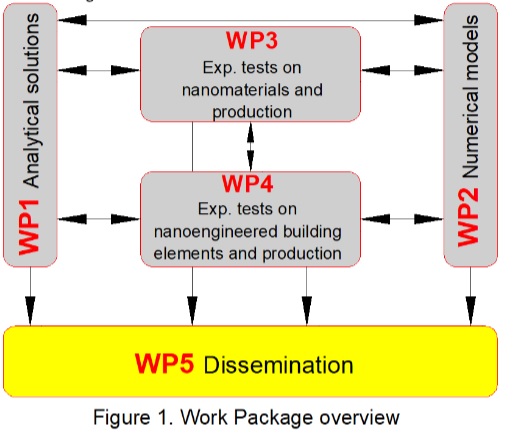Brief Description of the proposal
The recent researches on nanomaterials and nanotechnologies have highlighted the potential use of nanomaterials in various fields. The construction sector can be a major beneficiary, with applications that can improve either the characteristics of building elements (when used on their surface) or the characteristics of conventional or advanced construction materials (when added to their matrices). We speak of nanotechnology for structures in the first case, whereas we speak of nanotechnology for construction materials in the second case. Nanoengineering applied to construction materials makes it possible to respond both to the growing demand for enhancing construction materials (with satisfactory performances and delayed degradation) and to the demand for energy savings (a high percentage of energy is consumed by commercial warehouses and residential buildings). However, the use of nanomaterials in constructions is currently reduced, mainly for the following reasons: limited knowledge on nanomaterials suitable for constructions and their behavior, lack of specific standards for design and execution of construction elements using nanomaterials, reduced market supply of nanoproducts, high costs, unknown health risks associated with nanomaterials, and poor recyclability of nanomaterials at the end of their lives.
In order to be able to use nanomaterials in the construction industry on a large scale, it is therefore necessary that research is carried out according to the following steps: (1) choice of nanomaterials of potential use in constructions, and study of their characteristics; (2) study of the behavior of building elements that contain nanomaterials (that is, building elements made of nanocomposites) under different types of loading; (3) development of specific design and construction standards.
As a matter of fact, a literature search indicates that the available information is incomplete. Therefore, the main goal of the present project is to develop steps (1) and (2) in depth, both to overcome the lack of knowledge and to propose, in the context of step (3), predictive formulas to be implemented into the construction national standards. The project is organized in 5 work packages (WP) – Figure 1. WP1 – ANALYTICAL SOLUTIONS WP2 – NUMERICAL MODELS WP3 – EXPERIMENTAL TESTS ON NANOMATERIALS AND PRODUCTION WP4 - EXPERIMENTAL TESTS ON NANOENGINEERED BUILDING ELEMENTS AND PRODUCTION WP5 - DISSEMINATION
The first four WPs aim at an in-depth development of steps (1) and (2). More precisely, WPs 1 and 2 concern simulations of nanostructures and nanocomposites, performed from a fundamental bottom-up prospective, by employing both analytical solutions and numerical models. WP3 concerns material/mechanical characterization of nanomaterials and production. WP4 concerns mechanical characterization of nanocomposites in both normal and extreme environmental conditions and production. WPs 3 and 4 also allow to assess the accuracy of the above solutions and models. WP5 is dedicated to the dissemination actions, including the development of specific design guidelines for using such materials in civil infrastructures.

The original and innovative aspects of the project, aimed at overcoming the state of the art in the specific scientific area (i.e. advanced and green construction materials), are highlighted below.